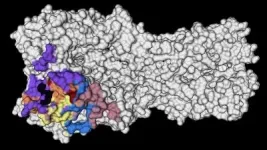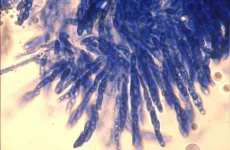(Press-News.org) Lauren Dreier was paging through a 19th century book by the German architect Gottfried Semper when she spotted some intriguing patterns inspired by lace. A professional artist and designer who often incorporates technology into her work, Dreier, who is also a doctoral student at the School of Architecture at Princeton University, decided to recreate the printed illustrations in 3D.
She grabbed ribbon-like plastic material she had been experimenting with in her studio, bending and connecting the semi-rigid strips. To Dreier's surprise, the structure she built assumed a bumpy geometry, with four distinct hills and valleys. "I thought it would make a dome, but it was this unusual shape," Dreier said. Curious to know what caused this unexpected twist, she reached out to Sigrid Adriaenssens, an associate professor in Princeton's Department of Civil and Environmental Engineering. Adriaenssens couldn't explain it, either, but she, too, was intrigued. She proposed a joint investigation to find out what was behind the strange structural mechanics.
Dreier's discovery wound up leading to the creation of a reconfigurable structure the researchers termed a bigon ring. By tweaking the specific design of the structure's patterns, the team was able to produce multiple geometries that arise from different looping behaviors. According to a paper describing the findings in the Journal of the Mechanics and Physics of Solids, the numerical framework behind the discovery can be applied to any general elastic rod network, whether made of thread, bamboo or plastic. It could also lead to the creation of new products and technologies that are capable of changing shape to improve performance under variable conditions from spacecraft to wearable technology.
"Drawing inspiration from patterns in lacing, I think we can say nobody's done that before," Adriaenssens said. "Some of these behaviors were very unexpected, and just by adjusting the angle or the width, you get a totally different behavior."
To investigate the physics behind these observations, Dreier worked closely with several collaborators, including Tian Yu, a postdoctoral researcher in Adriaenssens' lab. "This is my first time working with an artist, and I never expected to work on a project inspired by lace," Yu said. "I'm fascinated by the mechanics part of this project."
Unlike traditional lace makers who use soft threads twisted together, the researchers arranged their creations into loose, looping formations. "It's all about creating excess space between the nodes," Dreier said. The team started by making closed structures called bigons by fixing the ends of two initially straight strips at a certain angle, creating eye- or almond-like forms. Similar to metal hair clips from the 1990s, the bigons exhibited bistability, or two different stable shapes that the structures could toggle between when slight pressure was applied.
From there, the researchers arranged multiple bigons into a chain, and then a loop by connecting their ends. The bistable bigons together created an overall structure that could form numerous possible geometries. The structures were multistable, meaning they were made up of a collection forms each of which could be stable independent of the others. Bigon rings, as they called these new forms, sometimes exhibited a similar folding behavior as a bandsaw blade, looping back on themselves. But their behavior could also be tuned by adjusting the intersection angle and the aspect ratio of the strips that composed the bigons, and by changing the number of bigons that made up the ring.
As Dreier worked on building these structures, Yu created a numerical model specific to them using Kirchhoff rod equations for how a thin, elastic rod behaves when loaded with forces and displacements. The researchers were able to confirm the accuracy of the model by taking measurements from Dreier's physical creations and comparing the results. The computational model also made it possible to identify different configurations that the bigons or bigon rings might be able to take theoretically. The researchers then tested those mathematical predictions through the physical models to see which equilibria were stable and which were not. "A lot of back and forth came from Tian going deep into the data and saying, 'If you make a six-bigon ring at such-and-such an angle, what happens?'" Dreier said.
The team eventually produced a new numerical model that captures multistable behavior, and that the researchers say can be applied to other studies that examine the mechanics of general interlaced elastic networks.
In future work, the team plans to conduct a more extensive investigation of the many shapes that bigon-based structures are capable of forming, and how to best achieve specific target shapes. Eventually, their findings could lead to new designs for materials that need to be packed to take up as little room as possible, but that assume a much larger form when unpacked. "For example, materials and structures that go into space have to be folded into a bundle, put in a rocket and then have to expand into as large a size as possible," Adriaenssens said. "Some of these combinations of parameters do that."
Other potential real-world applications include novel soft robotic arms, toys and wearable technology. The latter, for example, could include special textiles that stiffen to support someone's arm in a certain position, and loosen in others. "It can envelop things or not, stiffen or not," Adriaenssens said. "It can have many functions."
In addition to the practical applications of the work, the project also demonstrates the largely untapped value of interdisciplinary collaboration between artists and engineers. While art tends to be driven by intuition and feelings that operate outside of the realm of scientific thinking, "it can lead to discoveries of some interesting phenomena," Dreier said. "I was really excited that these different worlds could come together in a very relevant way."
INFORMATION:
Besides Adriaenssens, Dreier and Yu, co-authors include Stefana Parascho, of the Princeton School of Architecture; Stefano Gabriele, of Roma Tre University; Francesco Marmo, of the University of Naples Federico II. Support for the project was provided in part by the Princeton School of Engineering and Applied Sciences Project X Fund, the Princeton University Magic Grants for Innovation and The Council for International Teaching and Research.
A new study from the University of Chicago and Scripps Research Institute shows that during the last great pandemic--2009's H1N1 influenza pandemic--people developed strong, effective immune responses to stable, conserved parts of the virus. This suggests a strategy for developing universal flu vaccines that are designed to generate those same responses, instead of targeting parts of the virus that tend to evolve rapidly and require a new vaccine every year.
Influenza is an elusive and frustrating target for vaccines. There are two main types of flu virus that can infect humans, which evolve rapidly from season to season. ...
Neurological and psychiatric symptoms such as fatigue and depression are common among people with Covid-19 and may be just as likely in people with mild cases, according to a new review study led by a UCL researcher.
By reviewing evidence from 215 studies of Covid-19, the meta-analysis published in the Journal of Neurology, Neurosurgery and Psychiatry reports a wide range of ways that Covid-19 can affect mental health and the brain.
Lead author Dr Jonathan Rogers (UCL Psychiatry and South London and Maudsley NHS Foundation Trust) said: "We had expected that neurological and psychiatric symptoms would be ...
Researchers have re-animated specimens of a fungus that causes coffee wilt to discover how the disease evolved and how its spread can be prevented.
Coffee Wilt Disease is caused by a fungus that has led to devastating outbreaks since the 1920s in sub-Saharan Africa, and currently affects two of Africa's most popular coffee varieties: Arabica and Robusta.
The new research shows that the fungus likely boosted its ability to infect coffee plants by acquiring genes from a closely related fungus, which causes wilt disease on a wide range of crops, including ...
Sea ice in the coastal regions of the Arctic may be thinning up to twice as fast as previously thought, according to a new modelling study led by UCL researchers.
Sea ice thickness is inferred by measuring the height of the ice above the water, and this measurement is distorted by snow weighing the ice floe down. Scientists adjust for this using a map of snow depth in the Arctic that is decades out of date and does not account for climate change.
In the new study, published in the journal The Cryosphere, researchers swapped this map for the results of a new computer model designed to estimate snow depth as it varies year to year, and concluded that sea ice in key ...
Concerns about side effects and whether vaccines have been through enough testing are holding people back from getting vaccinated against COVID-19, according to a new report.
Data from an international survey of 15 countries* which ran between March and May this year showed that these were the most commonly cited reasons for not having had a coronavirus vaccine yet, in addition to not being eligible for one. Respondents' other commonly reported reasons included concerns about not getting the vaccine they would prefer, and worries over whether the vaccines are effective enough.
Led by Imperial College London's Institute of Global Health Innovation in collaboration with YouGov, the survey also looked at trust in COVID-19 vaccines. ...
A University of Birmingham-led study funded by the UK Coronavirus Immunology Consortium has found that many patients with COVID-19 produce immune responses against their body's own tissues or organs.
COVID-19 has been associated with a variety of unexpected symptoms, both at the time of infection and for many months afterwards. It is not fully understand what causes these symptoms, but one of the possibilities is that COVID-19 is triggering an autoimmune process where the immune system is misdirected to attack itself.
The study, published today (June 4) in the journal Clinical & Experimental Immunology, investigated the frequency and types of common ...
Under embargo until Thursday 3 June, 23:30 UK time / 18:30 US Eastern time
Peer-reviewed observational study in people
Prior Covid-19 infection reduces infection risk for up to 10 months
The risk of being infected with SARS-CoV-2, the virus that causes Covid-19, is substantially reduced for up to 10 months following a first infection, according to new findings from the Vivaldi study led by UCL researchers.
For the study, published in Lancet Healthy Longevity, researchers looked at rates of Covid-19 infections between October and February among more than 2,000 care home residents and staff, comparing those who had evidence of a previous infection up to 10 months earlier, as determined by antibody testing, with those who had ...
Levels of antibodies in the blood of vaccinated people that are able to recognise and fight the new SARS-CoV-2 Delta variant first discovered in India (B.1.617.2) are on average lower than those against previously circulating variants in the UK, according to new laboratory data from the Francis Crick Institute and the National Institute for Health Research (NIHR) UCLH Biomedical Research Centre, published today (Thursday) as a Research letter in The Lancet.
The results also show that levels of these antibodies are lower with increasing age and that levels decline over time, providing additional evidence in support of plans to deliver a vaccination boost to vulnerable people in the Autumn. ...
An immunotherapy drug given after surgery improved disease-free survival rates in patients with kidney cancer at high risk of relapse.
Interim results of a phase 3 trial of adjuvant therapy revealed a 32% decrease in the risk of recurrence or death with pembrolizumab compared with a placebo
This is the first positive study of immunotherapy in patients with kidney cancer at high risk of relapse.
BOSTON -- Treatment with an immunotherapy drug following kidney cancer surgery, prolonged disease-free survival rates in patients at high risk for recurrence, according to an interim ...
Sickle cell disease (SCD) is the most common deadly genetic disorder, affecting more than 300,000 newborns worldwide each year. It leads to chronic pain, organ failure, and early death in patients. A team led by researchers at the Broad Institute of MIT and Harvard and St. Jude Children's Research Hospital has now demonstrated a base editing approach that efficiently corrects the mutation underlying SCD in patient blood stem cells and in mice. This gene editing treatment rescued the disease symptoms in animal models, enabling the long-lasting production of healthy blood cells.
The root of SCD is two mutated copies of the hemoglobin gene, HBB, which cause red ...



